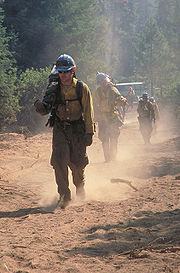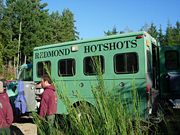
Hotshot crew
Encyclopedia

Physical fitness
Physical fitness comprises two related concepts: general fitness , and specific fitness...
standards, and ability to undertake difficult, dangerous, and stressful assignments. They often respond to large, high-priority fires and are trained and equipped to work in remote areas for extended periods of time with little logistical support.
As an interagency resource, hotshot crews can be requested to respond to wildland fire incidents in any jurisdiction. As of 2009, there are 107 IHCs in operation in the United States, organized by diverse agencies such as the United States Forest Service
United States Forest Service
The United States Forest Service is an agency of the United States Department of Agriculture that administers the nation's 155 national forests and 20 national grasslands, which encompass...
, National Park Service
National Park Service
The National Park Service is the U.S. federal agency that manages all national parks, many national monuments, and other conservation and historical properties with various title designations...
, Bureau of Indian Affairs
Bureau of Indian Affairs
The Bureau of Indian Affairs is an agency of the federal government of the United States within the US Department of the Interior. It is responsible for the administration and management of of land held in trust by the United States for Native Americans in the United States, Native American...
, Bureau of Land Management
Bureau of Land Management
The Bureau of Land Management is an agency within the United States Department of the Interior which administers America's public lands, totaling approximately , or one-eighth of the landmass of the country. The BLM also manages of subsurface mineral estate underlying federal, state and private...
, as well as state, county, and city governments. The National Interagency Fire Center
National Interagency Fire Center
The National Interagency Fire Center in Boise, Idaho, is the physical facility that is home to the National Interagency Coordination Center , and the National Multi-Agency Coordination group ....
in Boise, Idaho coordinates Hotshot crews on the national level.
Hotshot crews trace their history to Southern California
Southern California
Southern California is a megaregion, or megapolitan area, in the southern area of the U.S. state of California. Large urban areas include Greater Los Angeles and Greater San Diego. The urban area stretches along the coast from Ventura through the Southland and Inland Empire to San Diego...
in the late 1940s on the Cleveland
Cleveland National Forest
Cleveland National Forest encompasses 460,000 acres , mostly of chaparral, with a few riparian areas. A warm dry mediterranean climate prevails over the Forest. It is the southernmost National forest of California. It is administered by the United States Forest Service, a government agency within...
and Angeles National Forest
Angeles National Forest
The Angeles National Forest of the U.S. National Forest Service is located in the San Gabriel Mountains of Los Angeles County, southern California. It was established on July 1, 1908, incorporating the first San Bernardino National Forest and parts of the former Santa Barbara and San Gabriel...
. The term "hotshot" comes from their having been assigned to the hottest parts of the fire. In American English, the term also connotes "a person who is conspicuously talented or successful".
While not fighting fires, hotshot crews typically work in their home units to meet resource goals such as thinning
Thinning
Thinning is a term used in agricultural sciences to mean the removal of some plants, or parts of plants, to make room for the growth of others.- Forestry :...
, prescribed fire
Controlled burn
Controlled or prescribed burning, also known as hazard reduction burning or Swailing is a technique sometimes used in forest management, farming, prairie restoration or greenhouse gas abatement. Fire is a natural part of both forest and grassland ecology and controlled fire can be a tool for...
operations, habitat improvement, and trail construction projects. Hotshot crews can also respond to other emergency incidents, including search and rescue
Search and rescue
Search and rescue is the search for and provision of aid to people who are in distress or imminent danger.The general field of search and rescue includes many specialty sub-fields, mostly based upon terrain considerations...
and disaster response
Disaster response
Disaster response is a phase of the disaster management cycle. Its preceding cycles aim to reduce the need for a disaster response, or to avoid it altogether.The level of disaster response depends on a number of factors and particular situation awareness...
. For example, in 2009 the Cherokee IHC was assigned to clear trees downed by rare tornadoes in Prospect Park
Prospect Park (Brooklyn)
Prospect Park is a 585-acre public park in the New York City borough of Brooklyn located between Park Slope, Prospect-Lefferts Gardens, Kensington, Windsor Terrace and Flatbush Avenue, Grand Army Plaza and the Brooklyn Botanic Garden...
and Kissena Park
Kissena Park
Kissena Park is a large park located in the neighborhood of Flushing in the New York City borough of Queens, along Kissena Creek which formerly flowed into the Flushing River. It is bordered on the west by Kissena Boulevard; on the north by Rose, Oak, Underhill, and Lithonia Avenues; on the east...
in New York City, their first employment in an urban setting.
Operations
Hotshot crews are known for their extensive training, and are expected to display proficiency in the full range of fire suppression tactics. Like other handcrews, IHCs are primarily tasked with constructing, firing out, and holding handlineFirebreak
A firebreak is a gap in vegetation or other combustible material that acts as a barrier to slow or stop the progress of a bushfire or wildfire. A firebreak may occur naturally where there is a lack of vegetation or "fuel", such as a river, lake or canyon...
, through the use of chainsaw
Chainsaw
A chainsaw is a portable mechanical saw, powered by electricity, compressed air, hydraulic power, or most commonly a two-stroke engine...
s, hand tools, ignition devices, and water delivery equipment. Hotshot crews can engage in all phases of wildfire response, from initial attack to mop-up. They are also trained in specialized operations, such as hot spotting, spot fire attack, tree felling
Felling
Felling is the name given to an area of land in eastern Gateshead, England. Originally an independent settlement in the historic county of Durham it became incorporated into the Metropolitan Borough of Gateshead in 1974....
, and structure protection.
The life

Controlled burn
Controlled or prescribed burning, also known as hazard reduction burning or Swailing is a technique sometimes used in forest management, farming, prairie restoration or greenhouse gas abatement. Fire is a natural part of both forest and grassland ecology and controlled fire can be a tool for...
and fuels reduction.
Living conditions while on assignments can be primitive. Fresh meals, soft beds, and regular showers are not to be expected. Field assignments away from home can last several weeks with daily work shifts averaging 16 hours, but can extend up to 48–64 hours. Sleep deprivation is common, as is routine exposure to dust, smoke, poison oak, extreme weather (both heat and cold) and other environmental hazards.
Hotshot vehicles become a home away from home during the peak of the season when Hotshots may rarely spend more than two consecutive days at their own station. These vehicles, also known as Crew Hauls, Buggies, Crummies, or simply the Box, carry Hotshots along with personal gear, tools, and everything else necessary to make the crew self-sufficient for several days.
Crew breakdown

The first format is:
- One GS-9 superintendent;
- Two GS-8 foremans, (also known as captains or assistant superintendents)
- Two GS-6/7 squad leaders;
- Two – Four GS-5 senior firefighters; and
- Approximately twelve GS-4 and/or GS-3 temporary firefighters.
The second format is
- One GS-9 superintendent;
- One GS-8 assistant superintendents;
- Three GS-6/7 squad leaders;
- Three GS-5 senior firefighters; and
- Approximately twelve GS-4 and/or GS-3 temporary firefighters.
In addition, crewmembers are assigned various other specialized roles within the crew structure.
These specialties may include:
- Medic – certified as first responders, wilderness first responders, emergency medical technician-level B or higher.
- Helicopter crewmember (HECM) – responsible for manifesting and packaging crew supplies and equipment into "sling-loads" for transport by helicopter long-line into and out of remote locations.
- Faller – Highly skilled chainsaw operators that specialize in the safe falling of hazardous snags and burning or damaged trees.
- Saw team – Consisting of one sawyerSawyerSawyer is an occupational term referring to someone who saws wood. One such job was the now-archaic occupation of someone who cut lumber to length for the consumer market, a task now done by end users or at lumber and home improvement stores...
and one "swamperSwamper (occupational title)A swamper in occupational slang is an assistant worker, helper, maintenance man or a person who performs odd jobs. The term has its origins circa 1857 in the southern United States to refer to a workman who cleared roads for a tree feller in a swamp, according to the Oxford English Dictionary...
"; The sawyer will use a chain saw to cut brush and woody material away from the fires edge while the swamper pulls and throws the cut material to the non-fire side of the fireline. These teams sometimes trade tasks with each tank of fuel used in the chain saw. The reason for this being that both cutting with the saw and swamping are both physically exhausting, but in different ways, therefore, trading tasks allows the team to do more work for longer. Also, operating the chainsaw is usually a more desirable task, compared to throwing brush and limbs, so trading tasks is more equitable.
Physical fitness
In order to effectively perform their duties, Hotshots must maintain a high level of physical fitness. Whenever they are not on a fire assignment, crews devote at least one hour a day to physical training (PT). This training can include steep hikes, weight lifting, and long-distance runs. Traditionally, 5- to 10-mile runs were the favored PT for hotshot crews. Recently, there has been a shift towards more hiking. On these hikes, Hotshots may climb without stopping for over an hour while carrying upwards of 60 lbs. in gear and tools.At a bare minimum, each Hotshot must complete a 3-mile hike carrying a 45 pound pack in under 45 minutes. Other minimum PT standards commonly adhered to are, 1½-mile run in 10:35 or less, 30+ push-ups in 60 seconds, 45+ sit-ups in 60 seconds, and 7 pull-ups. These standards are an absolute minimum, and most hotshots' capabilities far exceed those numbers.
See also
- Fire Use ModuleFire Use ModuleA Fire use module is a 7–10 person team of US national parks service personnel dedicated to planning, monitoring and starting fires. They may be deployed anywhere in the United States for resource benefits , prescribed fire and hazard fuel reduction projects.As inter-agency national resource...
- SmokejumperSmokejumperA smokejumper is a wildland firefighter who parachutes into a remote area to combat wildfires.Smokejumpers are most often deployed to fires that are extremely remote. The risks associated with this method of personnel deployment are mitigated by an extremely well developed training program that has...
- Wildland fire engineWildland fire engineWildland fire engines use special equipment to spray water, foam, and chemicals. The engines are able to carry up to of water. Many wildland fire engines are also equipped with four wheel drive and special equipment for off-road use.*...
- Wildland fire tenderWildland fire tenderA wildland fire tender is a specialized vehicle capable of bringing water, foam, or dry chemicals to fire trucks in the field that are engaged on the fireline...
- Wildland fire suppressionWildland fire suppressionWildfire suppression refers to the firefighting tactics used to suppress wildfires. Firefighting efforts in wildland areas requires different techniques, equipment, and training from the more familiar structure fire fighting found in populated areas...

